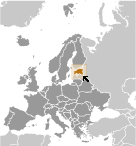World Atlas: Estonia. On this page you can see the map, country flag and many detailed information about the people, history and economy of Estonia.

Here you can find online selected information about the geography, inhabitants, government, economy and history of Estonia. Included are selected statistics, an overview map and the detailed map of Estonia. But let's start with the flag of Estonia here:
Estonia - Overview:
What you should know about Estonia? Let's start with this: After centuries of Danish, Swedish, German, and Russian rule, Estonia attained independence in 1918. Forcibly incorporated into the USSR in 1940 - an action never recognized by the US and many other countries - it regained its freedom in 1991 with the collapse of the Soviet Union. Since the last Russian troops left in 1994, Estonia has been free to promote economic and political ties with the West. It joined both NATO and the EU in the spring of 2004, formally joined the OECD in late 2010, and adopted the euro as its official currency on 1 January 2011.
Geography of Estonia
 Where on the globe is Estonia? The location of this country is Eastern Europe, bordering the Baltic Sea and Gulf of Finland, between Latvia and Russia. Total area of Estonia is 45,228 sq km, of which 42,388 sq km is land. So this is not a large country. How could we describe the terrain of the country? This way: marshy, lowlands; flat in the north, hilly in the south. The lowest point of Estonia is Baltic Sea 0 m, the highest point Suur Munamagi 318 m. And the climate is maritime; wet, moderate winters, cool summers.
Where on the globe is Estonia? The location of this country is Eastern Europe, bordering the Baltic Sea and Gulf of Finland, between Latvia and Russia. Total area of Estonia is 45,228 sq km, of which 42,388 sq km is land. So this is not a large country. How could we describe the terrain of the country? This way: marshy, lowlands; flat in the north, hilly in the south. The lowest point of Estonia is Baltic Sea 0 m, the highest point Suur Munamagi 318 m. And the climate is maritime; wet, moderate winters, cool summers.
Inhabitants of Estonia
Let's take a look how many people live in Estonia. The number is: 1,251,581 (July 2017 est.). So not so many people live here. Who lives here? Estonian 68.7%, Russian 24.8%, Ukrainian 1.7%, Belarusian 1%, Finn 0.6%, other 1.6%, unspecified 1.6% (2011 est.). What are the languages in Estonia? Estonian (official) 68.5%, Russian 29.6%, Ukrainian 0.6%, other 1.2%, unspecified 0.1% (2011 est.). And the religions: Lutheran 9.9%, Orthodox 16.2%, other Christian (including Methodist, Seventh-Day Adventist, Roman Catholic, Pentecostal) 2.2%, other 0.9%, none 54.1%, unspecified 16.7% (2011 est.). How old are the people in average? 42.7 years. We have to add that this number is the median - so one half of the people is older than this, one half is younger. And what is their life expectancy (at birth)? This: 76.9 years. Where the people live in Estonia? Here: a fairly even distribution throughout most of the country, with urban areas attracting larger and denser populations. The major urban areas of Estonia are: Tallinn (capital) 391,000 (2015).
Government and Economy of Estonia
The capital of Estonia is Tallinn and the government type parliamentary republic. Let's take a look at the administrative divisions - 15 counties (maakonnad, singular - maakond); Harjumaa (Tallinn), Hiiumaa (Kardla), Ida-Virumaa (Johvi), Jarvamaa (Paide), Jogevamaa (Jogeva), Laanemaa (Haapsalu), Laane-Virumaa (Rakvere), Parnumaa (Parnu), Polvamaa (Polva), Raplamaa (Rapla), Saaremaa (Kuressaare), Tartumaa (Tartu), Valgamaa (Valga), Viljandimaa (Viljandi), Vorumaa (Voru). Regarding the economy of Estonia, important industrial products are food, engineering, electronics, wood and wood products, textiles; information technology, telecommunications. Important agricultural products are grain, potatoes, vegetables; livestock and dairy products; fish. The most important export commodities are machinery and electrical equipment 30%, food products and beverages 9%, mineral fuels 6%, wood and wood products 14%, articles of base metals 7%, furniture and bedding 11%, vehicles and parts 3%, chemicals 4% (2016 est.) and the most important export partners are Sweden 17.9%, Finland 16%, Latvia 9.2%, Russia 6.5%, Lithuania 6%, Germany 5.9%, Norway 4.1% (2016). The most important import commodities are machinery and electrical equipment 28%, mineral fuels 11%, food and food products 10%, vehicles 9%, chemical products 8%, metals 8% (2015 est.) and the most important import partners are Finland 13%, Germany 11%, Lithuania 9%, Sweden 8.3%, Latvia 8.2%, Poland 7.2%, Netherlands 6.3%, Russia 5.7%, China 4.8% (2016). How rich is Estonia and how rich are people in this country? The most important number here is GDP per capita (PPP): $31,500 (2017 est.). This means the living standards are good here. Let's add that this means Gross Domestic Product per person, which is recalculated with respect to the relative cost of local goods and services. And one more important number - population below poverty line: 21.3% (2015 est.).